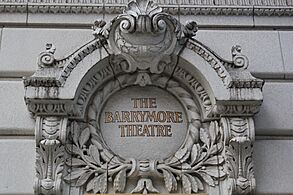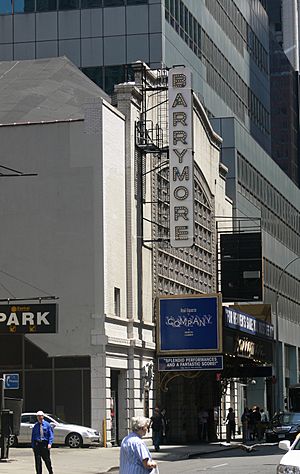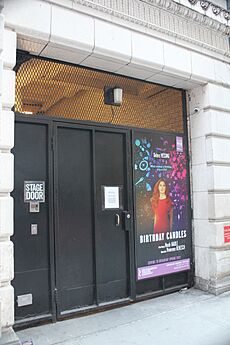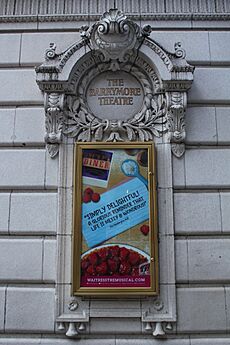Ethel Barrymore Theatre facts for kids
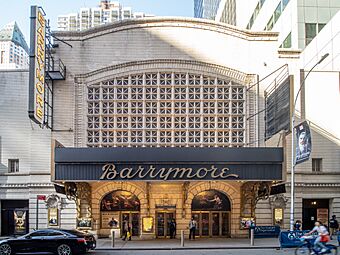 |
|
| Address | 243 West 47th Street Manhattan, New York United States |
|---|---|
| Coordinates | 40°45′36″N 73°59′10″W / 40.76000°N 73.98611°W |
| Owner | The Shubert Organization |
| Type | Broadway |
| Capacity | 1,058 |
| Construction | |
| Opened | December 20, 1928 |
| Years active | 1928–present |
| Architect | Herbert J. Krapp |
| Designated | November 4, 1987 |
| Reference no. | 1313 |
| Designated entity | Facade |
| Designated | November 10, 1987 |
| Reference no. | 1314 |
| Designated entity | Auditorium interior |
The Ethel Barrymore Theatre is a famous Broadway theater located at 243 West 47th Street in the Theater District of Midtown Manhattan, New York City. It first opened its doors in 1928. The theater was designed by Herbert J. Krapp for the Shubert family, who are well-known in the theater world. It was named after the famous actress Ethel Barrymore.
This theater has 1,058 seats and is still run by the Shubert Organization. Both the outside (facade) and the inside (auditorium) of the theater are considered important New York City landmarks. This means they are protected because of their historical and architectural value.
The outside of the theater has a cool design with terracotta blocks that look like rough stone. The main entrance has two large archways and a smaller door, all covered by a big sign called a marquee. The upper parts of the building feature an arched screen made of terracotta, inspired by old Roman buildings. The inside of the theater is decorated with fancy plasterwork, a sloped seating area on the main floor, a large balcony, and a curved ceiling with a big dome.
The Shubert brothers decided to build the Barrymore Theatre after Ethel Barrymore agreed to let them manage her acting career. It opened on December 20, 1928, with a play called The Kingdom of God. This was the last theater the Shuberts built before the Great Depression started. Ethel Barrymore only worked with the Shuberts until 1932 and last performed in the theater in 1940. The Barrymore Theatre has always been used for plays and musicals since it opened. It's special because it's one of the few Broadway theaters that has never been sold or renamed. The theater was updated in the 1980s and again in the 2000s.
Contents
Theater Location
The Ethel Barrymore Theatre is at 243 West 47th Street in New York City. It's on the north side of the street, between Eighth Avenue and Broadway. This area is known as the Theater District, close to Times Square. The theater building covers about 10,050 square feet. It shares the block with other theaters like the Samuel J. Friedman Theatre and the Longacre Theatre.
Theater Design
The Ethel Barrymore Theatre was designed by Herbert J. Krapp in 1928 for the Shubert brothers. It was named after the famous actress Ethel Barrymore (1879–1959). The theater is still run by the Shubert Organization. Unlike many other Broadway theaters, the Barrymore has always been used for live shows and has never changed its name or owner. It was the last theater built by the Shubert Organization until 2003.
Outside Look (Facade)
The front of the theater, called the facade, looks balanced and even. The bottom part is covered in terracotta blocks that look like rough stone, painted to resemble limestone. The main entrance has two large arched openings, each with four glass doors. Above these doors is a big marquee that says "Barrymore." This marquee is held up by fancy bronze supports.
On both sides of the doors, there are special spots with bronze signs. Above these signs are terracotta wreaths that have circular panels with the golden words "The Barrymore Theater." The upper parts of the building are made of white brick. The middle section has a terracotta screen with a design inspired by Ancient Roman patterns. This screen is about 52 feet wide.
Inside the Auditorium
The auditorium is where the audience sits to watch the show. It has a main floor (orchestra level), one balcony, and special box seats near the stage. The inside is decorated with plaster designs that don't stick out too much. The main seating area is almost square. The Shubert Organization says there are 1,058 seats. The seats were designed to be very comfortable. The theater's interior uses a mix of Elizabethan, Mediterranean, and Adam-style designs.
Seating Areas
At the back of the main floor, there's a walkway called a promenade. Two staircases lead from this promenade up to the balcony. They have metal railings with shield designs. The main floor slopes down towards the stage, which helps everyone see better. The side walls have wood panels.
The balcony hangs over the main floor and is split into front and back sections by an aisle. The front edge of the balcony has decorative patterns. Underneath the balcony, there are plaster panels with crystal lights.
On both sides of the stage, there are three special box seats, raised about 9 feet from the main floor. These boxes curve towards the side walls. The front of the boxes are decorated with three bands of Elizabethan-style plasterwork. Behind the boxes are tall, gold-colored columns.
Other Design Features
Near the box seats is the proscenium arch, which frames the stage. This arch is surrounded by wide bands with decorative patterns. The proscenium arch is about 24 feet 10 inches high and 39 feet 3 inches wide. The stage itself is about 28 feet deep and 81 feet wide.
The ceiling is about 49 feet high from the main floor. The curved ceiling has a dome in the middle, which is about 36 feet wide. A glass chandelier hangs from the center of the dome. The rest of the dome is divided into sections that look like wedges.
Other Inside Spaces
The theater also has a lounge area in the basement, which was about 25 by 50 feet. There were separate areas for women and men, and even a telephone booth. The lounge was decorated with an ivory-colored ceiling and old English-style furniture. When the theater first opened, a bronze statue of Ethel Barrymore was displayed there. The basement also had a large dressing room for the chorus.
On the first floor, Ethel Barrymore had her own modern reception and dressing room. The second floor had a chorus room and a smaller dressing room. The theater also had three more floors, each with four dressing rooms.
Theater History
The area around Times Square became a major spot for big theater shows between 1900 and the Great Depression. During the early 1900s, many theaters in Midtown Manhattan were built by the Shubert brothers, who were very powerful in the theater business. By 1925, the Shuberts controlled a lot of the plays and ticket sales in the U.S. They continued to build Broadway theaters in the 1920s.
How it Started and Early Years
In 1927, the Shubert brothers offered to build a Broadway theater and name it after Ethel Barrymore if she agreed to work with them. Barrymore said yes, and construction began in 1928. At that time, Ethel Barrymore was 48 and a very famous actress. The theater officially opened on December 20, 1928, with the play The Kingdom of God. Ethel Barrymore herself appeared in the play and received many cheers from the audience.
Ethel Barrymore performed at her theater again in 1929 in The Love Duel. Other plays followed, like Bird in Hand and Death Takes a Holiday, which ran for 181 shows.
1930s and 1940s
In the 1930s, the theater showed comedies like Topaze and The Truth Game. Ethel Barrymore appeared in Scarlet Sister Mary in 1930, which was her daughter Ethel Barrymore Colt's first Broadway show. In 1932, Ethel Barrymore stopped working with the Shuberts, and they even removed her first name from the marquee for a while. Later that year, Fred Astaire starred in the musical Gay Divorce.
Famous actors like Alfred Lunt, Lynn Fontanne, and Noël Coward performed in Design for Living in 1933. The theater had some tough times in 1934 with several shows that didn't do well. However, in December 1936, Clare Boothe Luce's play The Women, with an all-female cast, was a huge hit, running for 657 performances.
In 1938, the musical Knickerbocker Holiday was staged. The next year, No Time for Comedy with Katharine Cornell and Laurence Olivier ran for 185 shows. In 1940, Ethel Barrymore made her last appearance at her theater in An International Incident. The musical Pal Joey, featuring Gene Kelly, opened later that year and ran for 270 performances. Another hit was Best Foot Forward in 1941. In 1943, the war drama Tomorrow the World was very successful, with 499 performances.
In the mid-1940s, the theater often showed older, popular plays again. These included The Barretts of Wimpole Street and Pygmalion in 1945. In 1947, Tennessee Williams's famous play A Streetcar Named Desire opened, starring Marlon Brando and Jessica Tandy. This play was a massive hit, running for 855 performances over two years.
1950s to 1970s
In 1950, the play Bell, Book and Candle starring Rex Harrison and Lilli Palmer ran for 233 performances. Another married couple, Jessica Tandy and Hume Cronyn, starred in The Fourposter in 1951, which ran for 632 performances. In 1953, Tea and Sympathy with Deborah Kerr had 712 performances. In 1957, Look Homeward, Angel premiered and ran for 530 performances.
A Raisin in the Sun opened in March 1959 and ran for seven months. When Ethel Barrymore passed away in June 1959, the theater's lights were dimmed in her honor. In the early 1960s, the theater hosted plays like Critic's Choice with Henry Fonda in 1960, and Wait Until Dark in 1966. A revival of The Front Page was a hit in 1969.
The 1970s saw several award-winning shows at the Barrymore. In 1971, Melvin Van Peebles's musical Ain't Supposed to Die a Natural Death was performed. In 1974, Noël Coward's plays A Song at Twilight and Come Into the Garden, Maud were shown. The theater hosted American Buffalo with Robert Duvall and I Love My Wife in 1977. The play Romantic Comedy with Mia Farrow and Anthony Perkins was a hit in 1979. During this time, the Barrymore Theatre was one of the first theaters to offer electronic headsets for visitors who had trouble hearing.
1980s and 1990s
In the early 1980s, the Barrymore continued to host popular shows. These included The West Side Waltz with Katharine Hepburn in 1981. Hume Cronyn returned in 1982 with his first play, Foxfire, co-starring with Jessica Tandy. The musical Baby ran for 241 performances starting in late 1983. In 1984, Hurlyburly transferred from off-Broadway and ran for 343 performances. The August Wilson musical Joe Turner's Come and Gone opened in 1988.
In the late 1980s, the Shuberts updated the Barrymore as part of a plan to restore their Broadway theaters. The New York City Landmarks Preservation Commission decided to protect the Barrymore's facade as a landmark in 1987, and its interior shortly after. This was part of a bigger effort to protect many Broadway theaters. Even though the theater owners tried to challenge these landmark rules, the decisions were upheld in 1992.
In 1990, the play Lettice and Lovage opened, starring Maggie Smith. A special revival of A Streetcar Named Desire, featuring Alec Baldwin and Jessica Lange, opened in 1992. The play The Sisters Rosensweig moved to the Barrymore in 1993 and had 556 Broadway performances. In 1996, a revival of Oscar Wilde's An Ideal Husband ran for 306 performances. The musical The Life transferred to the Barrymore in 1997 and ran for 465 performances.
2000s to Present
In 2000, The Real Thing and The Tale of the Allergist's Wife were performed at the Barrymore. The Tale of the Allergist's Wife had a long run of 777 performances. In 2003, the Shuberts agreed to make their theaters, including the Barrymore, more accessible for people with disabilities. The Barrymore Theatre was then renovated for $9 million in 2004. A revival of Stephen Sondheim's musical Company opened in 2006, running for 247 performances. The theater's exterior was also renovated and finished in 2008.
The Barrymore hosted three plays by David Mamet in the late 2000s: November and Speed-the-Plow in 2008, and Race in 2009. In 2011, the play Arcadia was shown, along with a special show called An Evening with Patti LuPone and Mandy Patinkin. The theater hosted revivals of plays like Death of a Salesman in 2012, Macbeth in 2013, and A Raisin in the Sun in 2014. The play The Curious Incident of the Dog in the Night-Time opened in late 2014 and ran for almost two years.
In 2017, the Barrymore hosted The Present and Six Degrees of Separation. Later that year, the musical The Band's Visit opened and ran until early 2019. The play The Inheritance opened in November 2019 but had to close early on March 12, 2020, because of the COVID-19 pandemic.
The theater reopened on September 4, 2021, with a limited return of the musical Waitress. The musical Paradise Square ran for three months in 2022, followed by a revival of the play The Piano Lesson. In April 2023, the play Peter Pan Goes Wrong opened. In August 2023, Antonio Díaz's magic show El Mago Pop had a limited run. In October 2023, the musical Harmony by Barry Manilow and Bruce Sussman opened. The play Patriots opened in April 2024, and a limited run of Our Town followed in October 2024. A revival of Othello opened at the Barrymore in March 2025.
Notable Productions
Here are some of the important shows that have been performed at the Ethel Barrymore Theatre, listed by the year they first opened.
1920s to 1990s
| Opening year | Name | Refs. |
|---|---|---|
| 1929 | Death Takes a Holiday | |
| 1930 | Topaze | |
| 1930 | The Truth Game | |
| 1930 | Scarlet Sister Mary | |
| 1931 | Mélo | |
| 1931 | The School for Scandal | |
| 1932 | There's Always Juliet | |
| 1932 | Gay Divorce | |
| 1933 | Design for Living | |
| 1934 | Both Your Houses | |
| 1934 | Ruth Draper | |
| 1935 | Point Valaine | |
| 1935 | Othello | |
| 1935 | Macbeth | |
| 1936 | Bury the Dead | |
| 1936 | Night Must Fall | |
| 1936 | The Women | |
| 1938 | Knickerbocker Holiday | |
| 1939 | No Time for Comedy | |
| 1939 | Key Largo | |
| 1940 | Pal Joey | |
| 1941 | Best Foot Forward | |
| 1942 | R.U.R. | |
| 1943 | Three Sisters | |
| 1945 | Rebecca | |
| 1945 | The Barretts of Wimpole Street | |
| 1945 | Marinka | |
| 1945 | Pygmalion | |
| 1946 | The Duchess of Malfi | |
| 1946 | Cyrano de Bergerac | |
| 1947 | The Telephone/The Medium | |
| 1947 | A Streetcar Named Desire | |
| 1949 | The Rat Race | |
| 1950 | The Consul | |
| 1950 | Bell, Book and Candle | |
| 1951 | The Fourposter | |
| 1952 | I've Got Sixpence | |
| 1953 | Misalliance | |
| 1953 | Tea and Sympathy | |
| 1955 | The Desperate Hours | |
| 1955 | Marcel Marceau | |
| 1955 | The Chalk Garden | |
| 1957 | Small War on Murray Hill | |
| 1957 | Waiting for Godot | |
| 1957 | Look Homeward, Angel | |
| 1959 | A Raisin in the Sun | |
| 1959 | A Majority of One | |
| 1960 | The Hostage | |
| 1960 | Critic's Choice | |
| 1961 | The Complaisant Lover | |
| 1962 | Moby-Dick | |
| 1964 | The Passion of Josef D. | |
| 1965 | The Amen Corner | |
| 1966 | Wait Until Dark | |
| 1966 | We Have Always Lived in the Castle | |
| 1966 | Les Ballets Africains | |
| 1967 | Black Comedy/White Lies | |
| 1967 | The Little Foxes | |
| 1968 | Don't Drink the Water | |
| 1968 | The Seven Descents of Myrtle | |
| 1968 | Happiness Is Just a Little Thing Called a Rolls Royce | |
| 1968 | The Goodbye People | |
| 1969 | The Front Page | |
| 1970 | Conduct Unbecoming | |
| 1971 | The Philanthropist | |
| 1971 | Ain't Supposed to Die a Natural Death | |
| 1972 | Captain Brassbound's Conversion | |
| 1972 | Don't Play Us Cheap | |
| 1973 | The Visit | |
| 1973 | Holiday | |
| 1974 | A Song at Twilight/Come Into the Garden, Maud | |
| 1975 | The Night That Made America Famous | |
| 1975 | Travesties | |
| 1976 | Legend | |
| 1976 | Poor Murderer | |
| 1977 | American Buffalo | |
| 1977 | I Love My Wife | |
| 1979 | Romantic Comedy | |
| 1981 | The West Side Waltz | |
| 1982 | Is There Life After High School? | |
| 1982 | Foxfire | |
| 1983 | Baby | |
| 1984 | Hurlyburly | |
| 1986 | Social Security | |
| 1988 | Joe Turner's Come and Gone | |
| 1988 | The Secret Rapture | |
| 1989 | Rumors | |
| 1990 | Lettice and Lovage | |
| 1991 | Mule Bone | |
| 1992 | A Streetcar Named Desire | |
| 1993 | The Sisters Rosensweig | |
| 1995 | Indiscretions | |
| 1996 | An Ideal Husband | |
| 1997 | The Life | |
| 1998 | Electra | |
| 1999 | Amy's View | |
| 1999 | Putting It Together |
2000s to Present
| Opening year | Name | Refs. |
|---|---|---|
| 2000 | The Real Thing | |
| 2000 | The Tale of the Allergist's Wife | |
| 2002 | Imaginary Friends | |
| 2003 | Salome | |
| 2004 | Sly Fox | |
| 2005 | The Glass Menagerie | |
| 2006 | Ring of Fire | |
| 2006 | Company | |
| 2007 | Red Carpet Massacre | |
| 2008 | November | |
| 2008 | Speed-the-Plow | |
| 2009 | Exit the King | |
| 2009 | Race | |
| 2010 | Elling | |
| 2011 | Arcadia | |
| 2011 | An Evening with Patti LuPone and Mandy Patinkin | |
| 2012 | Death of a Salesman | |
| 2012 | Chaplin | |
| 2013 | Macbeth | |
| 2013 | Betrayal | |
| 2014 | A Raisin in the Sun | |
| 2014 | The Curious Incident of the Dog in the Night-Time | |
| 2016 | Alton Brown Live: Eat Your Science | |
| 2016 | The Present | |
| 2017 | Six Degrees of Separation | |
| 2017 | The Band's Visit | |
| 2019 | The Inheritance | |
| 2021 | Waitress | |
| 2022 | Paradise Square | |
| 2022 | The Piano Lesson | |
| 2023 | Peter Pan Goes Wrong | |
| 2023 | El Mago Pop | |
| 2023 | Harmony: A New Musical | |
| 2024 | Patriots | |
| 2024 | Our Town | |
| 2025 | Othello |
Box Office Records
Waitress set a new record for ticket sales at the Ethel Barrymore Theatre on September 3, 2021, earning $197,878 in one performance. This broke the previous record held by Betrayal, which made $184,476. This record was then broken again in August 2023 by El Mago Pop, which earned $2.717 million in just one week of ticket sales. In March 2025, Othello broke the all-time box office record for any Broadway theater, bringing in $2,818,297 over eight performances. This was partly due to very high ticket prices.
See also
- List of New York City Designated Landmarks in Manhattan from 14th to 59th Streets
- List of Broadway theaters




